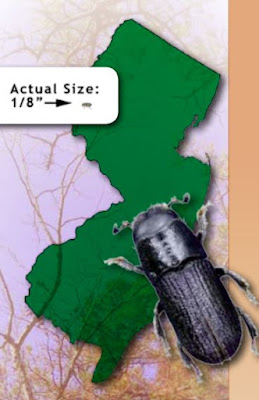The southern pine beetle (SPB), one of the most destructive forest insects in the southeastern United States, quickly devastates pine-dominated forests during outbreaks. This native bark beetle, which is smaller than a grain of rice, feeds on the living tissue under the tree’s bark and introduces blue stain fungi.
As pine dominant forests cover an estimated 440,000 acres in southern New Jersey, this beetle poses a considerable threat to our state’s forest resource. Since its re-entry into the state in 2001, SPB impacted approximately 26,600 total acres, and more than half that total occurred in 2010 alone.
Since 2001, SPB populations in New Jersey have been on the rise, destroying 1000 new acres of pine forests each year on average, but infestations remained largely confined to the southern sections of the state.
Then, in 2008, SPB crossed the Egg Harbor River for the first time and entered the pine forests of Atlantic County, and continues to move north and west.
A closer inspection may reveal pitch tubes on the trunk and S-shaped galleries under the bark. The beetle also transmits blue stain fungi, which stops water from circulating in the tree.
How To Report a Beetle Sighting
- Submit a Southern Pine Beetle NJ Sighting Report (PDF)
- Call the New Jersey Forest Service
- 609-625-1124 (Southern Region)
- 609-292-2531 (Trenton)
VIDEO: The Invasion of the Southern Pine Beetle


No comments:
Post a Comment